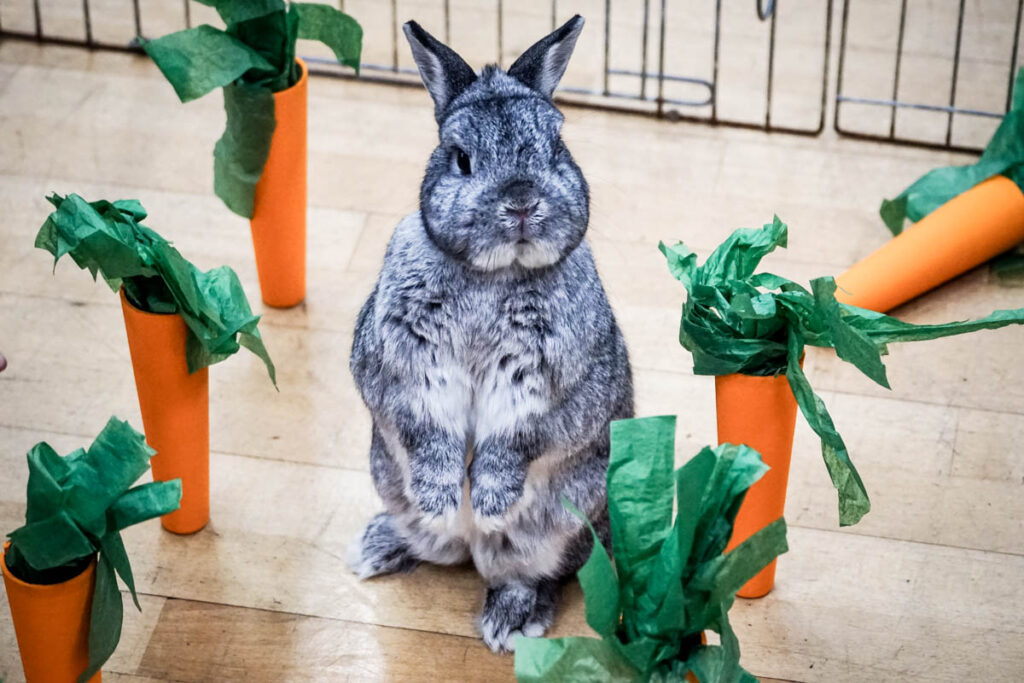Clicker training, a popular method used to train dogs and other animals, is also an effective way to train house rabbits. This positive reinforcement technique can enhance the bond between you and your rabbit while teaching them new behaviors and tricks. Here’s a comprehensive guide to get you started with clicker training for rabbits.
Understanding the Underlying Principals of Clicker Training
Clicker training is based on the scientific principle of operant conditioning, which uses rewards to reinforce desired behaviors. The clicker, a small handheld device that makes a distinct clicking sound, serves as a consistent marker to signal to your rabbit that they have performed the correct action and will receive a reward. The key to any clicker training is clicking at the exact moment they perform a desired behavior, followed by a quick treat. Rabbits quickly associate the click with the reward. Once a behavior is learned, it’s named with a voice or hand command, and the clicker is gradually used less. Treats continue to be important for reinforcement.
Benefits of Clicker Training for House Rabbits
Clicker training goes beyond teaching tricks; it has numerous benefits for both rabbits and their owners:
- Enhances Communication: Clicker training helps you communicate more effectively with your rabbit, strengthening your bond.
- Mental Stimulation: Learning new commands and tricks provides valuable mental stimulation for your rabbit, keeping them engaged and happy.
- Behavior Correction: This training method can also be used to discourage undesirable behaviors positively and constructively.
Getting Started
- Choose the Right Clicker: Select a clicker with a sound that is gentle enough not to startle your rabbit. Begin with the clicker in your pocket or behind your back or in some other way that helps to muffle the click.The goal is to get their attention, not to frighten them.
- Introducing the Clicker: Begin by associating the clicker sound with positive experiences. Click and immediately offer a treat. Repeat this process several times until your rabbit starts to associate the clicking sound with receiving a reward.
- Reward Basic Natural Behaviors: Once your bunny links the clicker to rewards, simply wait for them to perform a desired action, then click to mark the behavior, signaling a treat is coming. The behavior must be the rabbit’s choice, not forced. Utilize their natural behaviors, like standing on hind legs to look about, to encourage actions you want. Click and treat the moment they perform such actions. The precise timing is crucial for your rabbit to make the connection between the behavior, the click, and the reward.
Adding A Cue
- Start by giving the cue just as the rabbit begins to do the behavior: cue at behavior, then click and reward. Make sure the bunny has this pattern down before moving to the next transitional phase.
- Next, give the cue a bit earlier, just before he does the behavior or “trick”. From this point on, only click and treat if your bunny does the behavior after being cued. Do not click and treat if he offers the behavior without being prompted. Make sure the bunny has mastered this pattern before moving to the final phase.
- Finally, cue your bunny at random times to request the behavior. It’s important that the times be random and not just when he was about to offer up the behavior.
If, at any point, your bunny gets tired, upset, or distracted, it’s time to stop. When you stop, don’t forget to give him a treat to show appreciation for his effort. Don’t forget: It takes time and patience to clicker train your bunny. There needs to be lots of positive reinforcement along the way.
Basic Teachable Behaviors
Triangle Rabbits suggests “Targeting” and “Stand Up” are two good basic behaviors to begin with Triangle Rabbits materials are based on the work of Bob Betts.
Targeting1
- Hold the target stick in one hand and treats in the other.
- Remember that bunnies cannot see directly in front of them so hold the target stick near “Thumper’s” head, but a bit to one side. Be careful not to hit “Thumper’s” nose with the target.
- Eventually “Thumper” will become curious and touch it with his nose. The instant he touches it, click then treat.
- You should find now that if you move the target around, “Thumper” will chase after it and touch it with his nose. Click and treat when he does.
- Since a target is not used as a trick in itself you should not add a voice command. Voice commands are used with the behaviors that you teach using the target, such as “Spin”.
Stand Up2
- Hold the target (or a treat) over “Thumper’s” head. Do not say anything at all. Hold the target and clicker in one hand and the treat in the other hand. Be ready to click.
- When he stands on his hind legs to investigate, click the clicker and give the treat. Timing is vital. Be sure to click at the instant he stands on hind legs. Resist the urge to add any voice command – use ONLY the clicker.
- Repeat this for about 10 times or until “Thumper” is standing up reliably.
- If you are luring, switch hands and hold the clicker, instead of the treat, above “Thumper’s” head and have a handful of treats in the other hand. When he rises to the clicker, click and when he drops back down to all four feet, treat.
- Continue doing this until “Thumper” reliably comes up to the clicker.
- When the behavior is firmly fixed to the click you can add the voice command “Stand up.” When he stands up, click and treat.
- Wean from the clicker by using the voice command and when he stands click every other time and treat.
- Continue this routine, varying so the click happens less and less frequently as he starts responding to the voice command. Still treat every time. You should also add praise as he learns.
- Start making the treat intermittent. Treat sometimes but other times don’t treat. Continue to tell him what a great bunny he is.
More Complex Teachable Behaviors
Wabbit Wiki maintains a house rabbit training trick list that is quite extensive and supported by videos. Piano playing, jumping, going through an obstacle course, and crate training are but a few of the things that bunnies have been taught.
Top Tips
- Consistency is Key: Use the same clicker sound and reward system consistently to avoid confusing your rabbit.
- Use a reward your rabbit really appreciates. Our rabbits love Go Raw Sprouted pumpkin seeds. They are a perfect reward as they are tiny and bite sized.
- Short Sessions: Rabbits have short attention spans. Keep training sessions brief but frequent to maintain their interest.
- Patience and Positivity: Always maintain a positive attitude during training sessions. If you or your rabbit becomes frustrated, provide a treat for their effort, take a break and try again later.
Conclusion
Clicker training is a rewarding experience that can significantly improve your relationship with your house rabbit. By using positive reinforcement, you can teach your rabbit a variety of behaviors and tricks, all while providing them with mental stimulation and strengthening your bond. Remember, the key to successful clicker training lies in patience, consistency, and positivity. With these principles in mind, you and your rabbit can enjoy the many benefits of this effective training method.
Further Reading
- Clicker Bunny, Karen Pryor, Clicker Training
- Joan Orr, What? Train a Rabbit?
- House Rabbit Network, Joan Orr and Teresa Lewin, Clicker Training Your Rabbit
- Eve Alexander, Interview: Andrea Bratt Frick about clicker training rabbits
- Silicon Valley Humane Society, Intro To Clicker/Bridge Training
References
- Triangle Rabbits, “Clicker Training” ↩︎
- Triangle Rabbits, “Clicker Training” ↩︎

